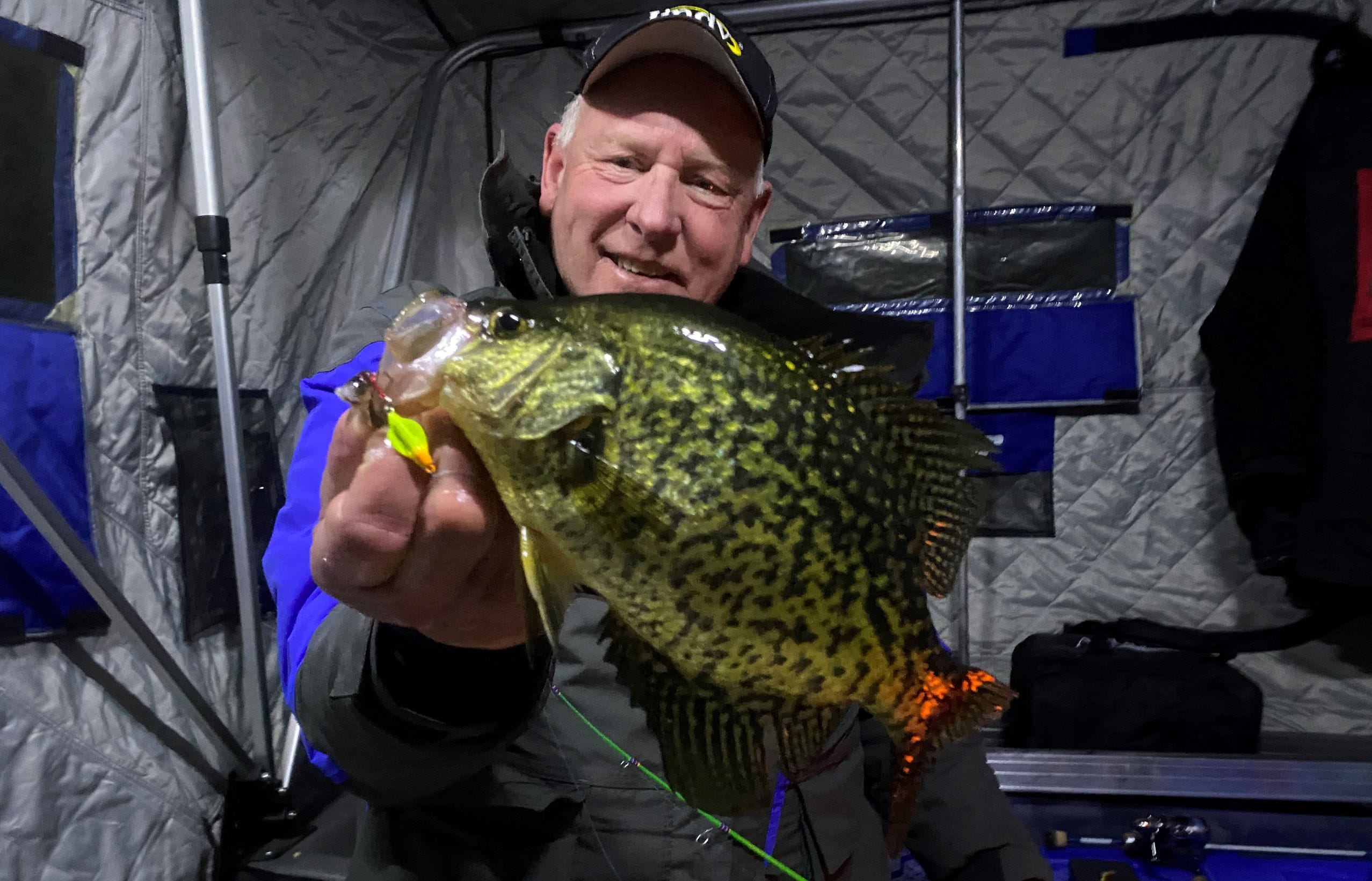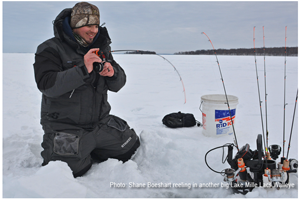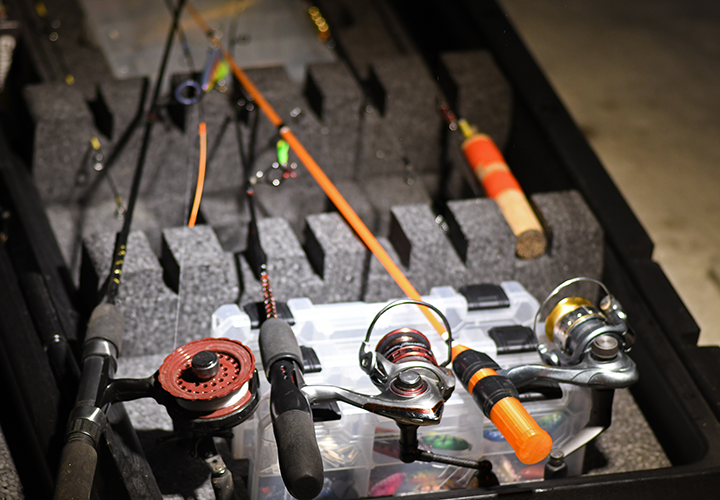
 It's somewhat unusual to have the same article published in 2 places at the same time, but that's the situation we have today. You see after I published the answers to the reader question about ice rods, reels and fishing line from Dave Heck yesterday, the folks at Lurenet emailed and asked if I might expand on those thoughts, adding some specific tips about fishing lures that fit into my favorite categories too.
It's somewhat unusual to have the same article published in 2 places at the same time, but that's the situation we have today. You see after I published the answers to the reader question about ice rods, reels and fishing line from Dave Heck yesterday, the folks at Lurenet emailed and asked if I might expand on those thoughts, adding some specific tips about fishing lures that fit into my favorite categories too.
If you already read the original article and were satisfied with those comments, thank you! If you missed the original, or would like to see the "expanded version" of it, follow the link below. It will take you to the Lurenet Pro Tips Blog and the full, updated version of the article. Good Luck Out There! ![]() — Jeff Sundin 218-245-9858 or EMAIL
— Jeff Sundin 218-245-9858 or EMAIL
 "Ice Fishing Gear: Selecting Rods, Reels and Line" — January 11, 2023
"Ice Fishing Gear: Selecting Rods, Reels and Line" — January 11, 2023
 Lurenet Pro Tips Article: "Whether at a fishing show or on the ice or through his popular daily fishing reports, Jeff Sundin commonly gets asked about the gear he uses for ice fishing. We’re excited to be able to share his answer to that question.
Lurenet Pro Tips Article: "Whether at a fishing show or on the ice or through his popular daily fishing reports, Jeff Sundin commonly gets asked about the gear he uses for ice fishing. We’re excited to be able to share his answer to that question.
Anglers sometimes ask about the rods, reels and lines I use for ice fishing. Like with any tool, the trick is to correctly match fishing rods and reels with the task that they’ll be required to perform. Having the “latest and greatest” (typical translation: most expensive) gear isn’t always the best solution.
High-end, specialized gear can offer certain tactical advantages, but sometimes there are trade-offs that ..." Learn More >> Select The Best Ice Rods, Reels and Lures January 11, 2023
More Recent Fishing Reports
Lake of the Woods 1-11 • Ely Area 1-11 • Ice Fishing Gear 1-10 • Trout Fishing 1-5 • Ely MN 1-4 • Lake of the Woods 1-4 • Grand Rapids 1-1 • Sundin 12-29 • DNR Roundtable 12-28 • Ely MN 12-28 • Follow on Facebook
 "Ice Fishing Gear: Selecting Rods, Reels and Line" — January 10, 2023
"Ice Fishing Gear: Selecting Rods, Reels and Line" — January 10, 2023
 Dave heck wrote with a couple questions regarding ice fishing equipment.
Dave heck wrote with a couple questions regarding ice fishing equipment.
Q) "Jeff, I've noticed in your videos with Jon (Thelen) that you use spinning reels quite often. Have you ever used in-line reels and what are some of the pros and cons of each reel.
Secondly, what ice fishing line do you prefer to use? This is only the second year I've ever ice fished and had an absolute ball my first year. I've been using the Sunline fishing line and am happy with it but was wondering if another line might be better. On the poles I purchased I’ve been using in-line reels but my 8-year-old grandkids have quite a bit of trouble with them. That's why I'd like your opinion on spinning reels.
Here in mid-eastern Iowa, we're still waiting for good ice and the grandkids are chomping at the bit to go. I want to get them set up with as trouble-free equipment as I can. Thanks in advance." Dave Heck
A) Dave, like any tools, the trick is correctly matching fishing rods and reels with the task that they’ll be required to perform. Having the “latest and greatest” technology, (typical translation; most expensive) isn’t always necessary, but in some situations, can offer certain tactical advantages.
 For me, walleye, perch, and pike fishing can be easily accomplished using very basic and affordable gear. You mentioned viewing some ice fishing videos and you may notice that in many of them, I’m holding an Ugly Stick in my right hand. At around $30, they are probably the most cost-efficient tools I have for catching fish using most of the more basic presentations. I use the same spinning reels on these that I have on my lightweight summer gear, so there’s no need to get reels devoted strictly to ice fishing. The Ugly sticks work great for typical jigging presentations using spoons, jigs and most lures weighing from 1-16 to 3-8 ounces. Line test weights from 4 to 8 pounds are standard for me.
For me, walleye, perch, and pike fishing can be easily accomplished using very basic and affordable gear. You mentioned viewing some ice fishing videos and you may notice that in many of them, I’m holding an Ugly Stick in my right hand. At around $30, they are probably the most cost-efficient tools I have for catching fish using most of the more basic presentations. I use the same spinning reels on these that I have on my lightweight summer gear, so there’s no need to get reels devoted strictly to ice fishing. The Ugly sticks work great for typical jigging presentations using spoons, jigs and most lures weighing from 1-16 to 3-8 ounces. Line test weights from 4 to 8 pounds are standard for me.
Catching light-striking crappies and sunfish can require higher levels of finesse and presentations are less suited to rudimentary fishing gear. Ice anglers from all walks of life tout the benefit of using light, 1-to-4-pound test line to trigger strikes from finicky panfish. Lighter weight lures and ultra-thin fishing lines require fishing rods with both softer and more sensitive blanks. This is important not just in terms of detecting light strikes, but also in terms of protecting your fine fishing lines from breaking while reeling in fish.
My best panfish rods are custom builds, some of them by my friend Bob Bohland and others put together by my nephew Chris Andresen. I’ve tried some medium to higher end retail fishing rods too and found St. Croix, Fenwick, 13 Fishing, and Tuned Up Custom Rods that all offered good models, well suited for finesse, panfish presentations. My list only scratches the surface, but these are the ones I’ve used personally. There are plenty of other great offerings out there and they merit consideration too.
The only real secret to picking a great rod for you is to focus on matching the lure weight, line strength and reel size. When these are all in balance, you’ll have a rig that pleases you. Most often, “sensitivity” is a function of physical weight. If everything else is equal, the rod with the lowest physical weight will likely be the most sensitive. Bear in mind that sensitivity often comes at the price of reduced strength. The most sensitive rods on the market are also the most prone to breaking and should be used by experts, not casual anglers.
Inline style fishing reels are purported to be effective in terms of minimizing line twist. Some experts say that panfish, sunfish, will shy away from lures that rotate excessively. In-line reels can help reduce that unwanted rotation and make it easier for anglers to hold their offering still, in turn, making it easier to trigger strikes. I think that these claims are true, having total control of your presentation probably will help you get more strikes. However, all that control comes at a price and having your spool tension and drag set correctly are essential. That’s fine for experts, but casual anglers may find keeping them under control to be more cumbersome. So, a high quality in-line might not be the ultimate choice for folks who don’t fish a lot.
I guess there are 5 or 6 inline reels in my garage, but right now, the only one traveling in my rod box is spooled with 30-pound braid and paired with a medium heavy action rod for lake trout and other larger fish. Of course, subjective, but I do feel that the spinning reels are perfectly fine for 95% of the routine situations I typically encounter. My spinning reels by the way, are a hodge-podge of brands, put together over time. If I was starting from scratch, Pfluger Presidents would get the nod. For the money, you will not find anything more reliable and like I said, they move from the ice kit into the boat for the open water fishing season, so the value is extended for sure.
Copolymer fishing lines are great for minimizing line freeze-up. Whenever your gear is subject to cold temperatures, this is the best type of line to use. There are several brands offering copolymer lines, but of the ones currently offered, Gamma is the only one I’ve used personally; it has performed exceptionally well for me.
Fishing in warm temperatures, like inside a shelter, allows more flexibility and then, almost any fishing line you like will work well enough. Specialty presentations using heavier lures aimed at larger fish typically require the use of both heavier rods and braided lines. This is a topic best suited for an article devoted specifically to the pursuit of big fish. But if you chase trophy walleye, pike or lake trout, braided line can be important. I have braid on the rods that I use for lake trout, and my heavy walleye rods are spooled with braid too.
To cover all the bases, I think 3 rods would be ideal. The first, the aforementioned 28-inch medium, or 30-inch, medium heavy action Ugly Stick, along with Pflueger’s size 25 president reel, spooled with Gamma ice line, 6 pound test will handle most standard jigging lures for walleye, perch and active panfish. The second, any high quality 28-to-30-inch light action rod, paired with Pflueger’s size 20 president reel and spooled with Gamma’s 1-to-3-pound test ice line covers the finesse presentations. Personally, I love the 2-pound test, but their 3-pound test is usually adequate, even for finicky panfish. Finally, a heavier action rod, 30 to 36 inches long, Pflueger’s size 30 president reel and 20-to-30-pound braid, is a nice option for presenting larger, heavier lures. When using braid, be sure to use a leader tied with clear, fluorocarbon line; mine are cut to about 18 inches.
As always, there is a lot of room for personal choice. So, if you like something, use it, especially if it allows you to fish more, while using less gear. ![]() — Office Cell Call or Text 218-245-9858 or EMAIL
— Office Cell Call or Text 218-245-9858 or EMAIL
Jeff Sundin is a full time fishing guide, outdoor writer and photographer. Learn about guided fishing trips and more, click >> More About Jeff Sundin.
Current Fishing Reports • Guided Fishing Trips • Current Video • Fishing Articles • Fishing Links • Contact
The Fishrapper, Fishing Blue Books, LLC • 715 Byington Ave • La Prairie, MN 55744 • 218-245-9858
copyright©2023 Fishing Blue Books, LLC All Rights Reserved - last revised 07/16/2023